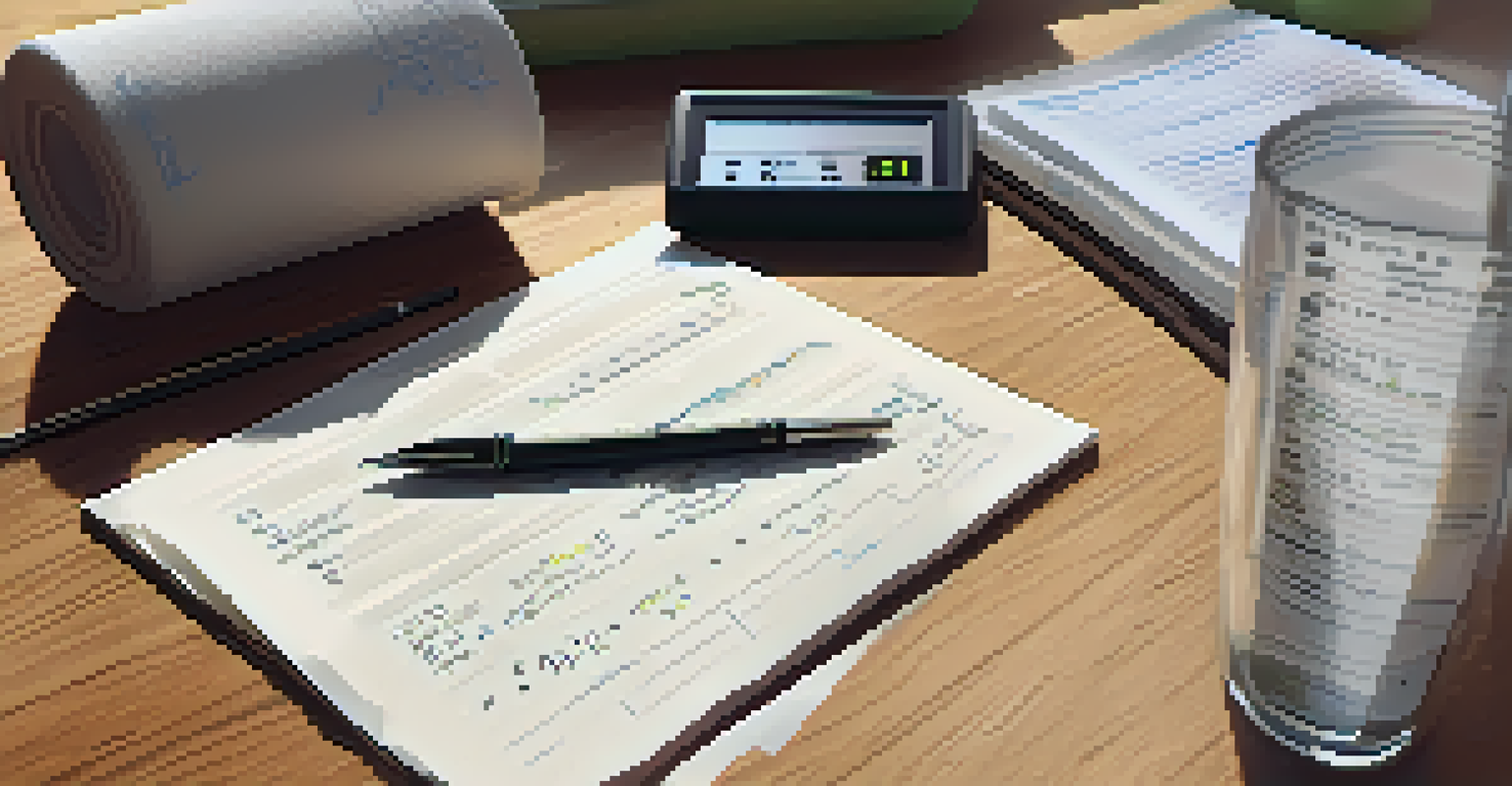Using RPE and RIR Metrics to Optimize Your Powerlifting

What Are RPE and RIR in Powerlifting?
RPE, or Rate of Perceived Exertion, and RIR, or Reps in Reserve, are critical metrics in powerlifting. RPE helps lifters gauge how hard they are pushing themselves during a workout, while RIR indicates how many more repetitions they could perform before reaching failure. Together, they provide valuable insights into managing workout intensity and volume effectively.
The body achieves what the mind believes.
Understanding these metrics allows you to tailor your training specifically to your current capabilities. For instance, if you're lifting at an RPE of 8, you know you're close to your limit but still have a couple of reps left in the tank. This information can help you adjust your efforts based on your fatigue levels on any given day.
By consistently tracking RPE and RIR, you can avoid overtraining and optimize your performance. This method gives you a clearer picture of your progress and helps you make informed decisions about when to push harder or take a step back.
Why Use RPE and RIR for Training Adjustments?
Incorporating RPE and RIR into your training routine allows for more personalized adjustments. Unlike fixed percentages of your one-rep max, these metrics consider your daily performance fluctuations, which can be influenced by factors like sleep, nutrition, and stress. This flexibility makes your training more responsive to your body's needs.

For example, if you're feeling fatigued and rate a set at an RPE of 9, you might decide to reduce the weight or volume for that session. This not only helps in preventing injury but also ensures you can maintain consistency in your training. The key is to listen to your body and adapt accordingly.
Understand RPE and RIR Metrics
RPE and RIR help lifters assess workout intensity and manage their training more effectively.
Additionally, using RPE and RIR can help promote a more mindful approach to lifting. You'll become more in tune with your body’s signals, which can enhance your overall lifting experience and lead to better long-term results.
How to Implement RPE in Your Workouts
To effectively implement RPE in your workouts, start by familiarizing yourself with the RPE scale, which typically ranges from 1 to 10. A rating of 1 indicates very light effort, while 10 represents maximum exertion. As you lift, take a moment to reflect on how challenging each set feels and assign a corresponding RPE score.
Success is the sum of small efforts, repeated day in and day out.
For instance, if you're performing squats and feel that you could only complete one more rep before failure, you would assign that set an RPE of 9. This practice encourages you to assess your effort levels and adjust your subsequent sets or workouts based on that feedback.
Over time, you’ll develop a better sense of your own limits and capabilities. This not only helps in making real-time adjustments but also aids in long-term planning of your training cycles, ensuring you’re always progressing at a sustainable rate.
Utilizing RIR for Effective Volume Management
RIR is a fantastic tool for managing training volume, especially when it comes to ensuring you're not overdoing it in the gym. By assessing how many reps you could still perform after completing a set, you can gauge whether you're pushing yourself adequately without entering the danger zone of overexertion.
For example, if you finish a set of deadlifts and determine that you could have done three more reps, you have an RIR of 3. This knowledge helps you adjust weights and set expectations for future workouts, allowing you to maintain an appropriate intensity level.
Personalize Your Training Approach
Using RPE and RIR allows for tailored adjustments based on daily performance fluctuations.
This metric also encourages you to think critically about your training. If you consistently find high RIR scores, it might be a sign that you need to increase weight or volume to continue progressing. On the flip side, if your RIR is consistently low, it may be time to evaluate your recovery and nutrition.
Combining RPE and RIR for Optimal Results
The true power of RPE and RIR comes from their combined use. By integrating both metrics, you can create a comprehensive training strategy that addresses both intensity and volume. This dual approach allows for a more nuanced understanding of your performance and helps you make better decisions in your training.
For instance, if you have an RPE of 7 but an RIR of just 1, it may indicate that while you’re not at your absolute limit, you’re also not pushing yourself enough to stimulate growth. Conversely, if your RPE is high but your RIR is also significant, you may need to dial back your intensity to avoid burnout.
Ultimately, the synergy of RPE and RIR provides a more holistic perspective on your training. This can lead to improved performance, reduced risk of injury, and more sustainable progress over time.
Tracking Your Progress with RPE and RIR
Tracking your RPE and RIR scores over time can reveal valuable insights about your training progress. Consider keeping a training log where you record your lifts alongside these metrics. This not only helps you reflect on your performance but also allows you to identify patterns that can inform future sessions.
For example, if you notice that your RPE is consistently lower during specific lifts, it could indicate that you're becoming stronger in those areas. Conversely, if your RIR is decreasing across the board, it might signal a need to reassess your recovery strategies or make adjustments to your training volume.
Track Progress for Better Results
Regularly logging RPE and RIR scores helps identify patterns in your training and informs future adjustments.
By regularly reviewing this data, you can make informed decisions about when to increase intensity, reduce volume, or try different variations of exercises. This proactive approach ensures that your training remains effective and aligned with your goals.
Common Mistakes to Avoid with RPE and RIR
While RPE and RIR are incredibly useful tools, they can also lead to confusion if not used correctly. One common mistake is misjudging your RPE, often due to factors like ego lifting or not paying attention to your body’s signals. It’s essential to stay honest with yourself and rate your exertion levels accurately, even if it means lifting lighter than you initially planned.
Another pitfall is neglecting to adjust your training based on these metrics. Just because you can lift a certain weight doesn’t mean you should every time. It’s crucial to balance progression with recovery, so be willing to scale back if your RPE or RIR indicates you need to.

Lastly, remember that RPE and RIR are not static; they can change from session to session. Always be prepared to adjust your expectations based on how you feel on any given day. Being flexible and responsive to these metrics will maximize your training effectiveness.